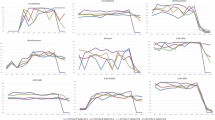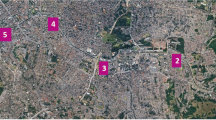Abstract
Nitrofurans, a kind of banned antibiotics for their serious toxic side effects, have often been found in aquatic products in the past and are still found nowadays which were a severe threat for human health. A rapid quantization of nitrofuran metabolites residues in aquatic products by ultra-high performance liquid chromatography–tandem mass spectrometry (UHPLC–MS/MS) method was developed in this study. The experimental operation consisted of an acid-catalyzed release of protein-bound metabolites, followed by derivatization with 2-chlorobenzaldehyde (2-CBA) and then extraction with ethyl acetate before analysis by positive electrospray ionisation (ESI+) with multiple reaction monitoring (MRM) type. 2-CBA was employed as derivatization reagent in this study, which greatly reduced the derivatization time. The linearity range for the four analytes were 0.25–50 μg kg−1 with good determination coefficients (R2 > 0.9982). The limit of detection (LOD) were 0.1 μg kg−1, 0.1 μg kg−1, 0.3 μg kg−1, 0.3 μg kg−1 and the limit of quantification (LOQ) were 0.3 μg kg−1, 0.3 μg kg−1, 0.9 μg kg−1, 0.9 μg kg−1 for AOZ, AMOZ, SEM, and AHD, respectively. Recovery rates were ranged from 90% to 114% for fortified samples at levels of 1.0 μg kg−1, 5.0 μg kg−1 and 10 μg kg−1 with relative standard deviation values ranging from 1.6% to 5.8%. The developed method was successfully applied in 100 aquatic products for NFs metabolites detection and the results were further confirmed by the national standard GB/T 21311-2007 method.



Similar content being viewed by others
References
Commission Decision (EC) 2003/181/EC (2003). Official Journal of the European Communities, L71, 17–18
Commission Regulation (EC) 1995/1442/EC (1995). Official Journal of the European Communities, 143, 26
Chen D, Delmas JM, Hurtaud-Pessel D, Verdon E (2020) Development of a multi-class method to determine nitroimidazoles, nitrofurans, pharmacologically active dyes and chloramphenicol in aquaculture products by liquid chromatography-tandem mass spectrometry. Food Chem 311(1):125924.1-125924.10
Diblikova I, Cooper KM, Kennedy DG, Franek M (2005) Monoclonal antibody-based elisa for the quantification of nitrofuran metabolite 3-amino-2-oxazolidinone in tissues using a simplified sample preparation. Anal Chim Acta 540(2):285–292
Douny C, Widart J, De PE, Silvestre F, Kestemont P, Tu HT et al (2013) Development of an analytical method to detect metabolites of nitrofurans: application to the study of furazolidone elimination in Vietnamese black tiger shrimp (Penaeus monodon). Aquaculture s 376–379(8):54–58
Fernando R, Munasinghe DMS, Gunasena ARC et al (2017) Determination of nitrofuran metabolites in shrimp muscle by liquid chromatography-photo diode array detection. Food Control 72:300–305
GB/T 21311-2007 (2007-10-29). Determination of residues of nitrofuran metabolites in foodstuffs of animal origin-HPLC-MS/MS method. Standardization Administration of the Peoples Republic of China
Hoogenboom LAP, Oorsprong MBM, Van Vliet T, Kuiper HA (1991) The use of pig hepatocytes for cytotoxicity studies of veterinary drugs: a comparative study with furazolidone and other nitrofurans. Toxicol In Vitro 5(1):31–38
Leitner A, Zöllner P, Lindner W (2008) Determination of the metabolites of nitrofuran antibiotics in animal tissue by high-performance liquid chromatography-tandem mass spectrometry. Food Sci 939(1):49–58
Li J, Liu JX, Wang JP (2009) Multidetermination of four nitrofurans in animal feeds by a sensitive and simple enzyme-linked immunosorbent assay. J Agric Food Chem 57(6):2181–2185
Mottier P, Khong SP, Gremaud E, Richoz J, Delatour T, Goldmann T et al (2005) Quantitative determination of four nitrofuran metabolites in meat by isotope dilution liquid chromatography-electrospray ionisation-tandem mass spectrometry. J Chromatogr A 1067(1–2):85–91
Paul MF, Paul HE, Bender RC, Kopko F, Harrington CM, Ells VR et al (1960) Studies on the distribution and excretion of certain nitrofurans. Antibiot Chemother 10:287–302
Xia X, Li XW, Zhang SX, Ding SY, Jiang HY, Li JC, Shen JZ (2008) Simultaneous determination of 5-nitroimidazoles and nitrofurans in pork by high-performance liquid chromatography-tandem mass spectrometry. J Chromatogr A 1208(1–2):101–108
Sheng LQ, Chen MM, Chen SS, Du NN, Liu ZD, Song CF (2013) High-performance liquid chromatography with fluorescence detection for the determination of nitrofuran metabolites in pork muscle. Food Addit Contam Part A 30(12):2114–2122
Van JEM, Wouters MFA, Van Leeuwen FXR (1993) Report of the 40th meeting of the joint FAO/WHO expert committee on food additives. World Health Organisation, Geneva, pp 85–123
Wang Q, Liu YC, Chen YJ, Jiang W, Shi JL, Xiao Y (2014) Development of a direct competitive Chemiluminescent Elisa for the detection of nitrofurantoin metabolite 1-amino-hydantoin in fish and honey. Anal Methods 6(12):4414
Yuan GX, Zhu Z, Yang P, Lu SY, Liu HH, Liu WJ (2020) Simultaneous determination of eight nitrofuran residues in shellfish and fish using ultra-high performance liquid chromatography–tandem mass spectrometry. J Food Compos Anal 92:103540
Zhang YB, Qiao HO, Chen C, Wang ZL, Xia XD (2016) Determination of nitrofurans metabolites residues in aquatic products by ultra performance liquid chromatography-tandem mass spectrometry. Food Chem 192:612–617
Author information
Authors and Affiliations
Corresponding author
Ethics declarations
Ethics statement
All procedures in this work were performed in compliance with relevant laws and institutional guidelines and that the appropriate institutional committee(s) has approved them.
Conflict of interests
There is no known competing financial interests that could have appeared to influence the work reported in this paper.
Additional information
Publisher's Note
Springer Nature remains neutral with regard to jurisdictional claims in published maps and institutional affiliations.
Rights and permissions
Springer Nature or its licensor holds exclusive rights to this article under a publishing agreement with the author(s) or other rightsholder(s); author self-archiving of the accepted manuscript version of this article is solely governed by the terms of such publishing agreement and applicable law.
About this article
Cite this article
Ouyang, X., Fan, Y., Huang, S. et al. Rapid and accurate quantification and analysis of nitrofuran metabolites residues in aquatic products by ultra-high performance liquid chromatography–tandem mass spectrometry. Eur Food Res Technol 248, 2857–2864 (2022). https://doi.org/10.1007/s00217-022-04095-8
Received:
Accepted:
Published:
Issue Date:
DOI: https://doi.org/10.1007/s00217-022-04095-8




